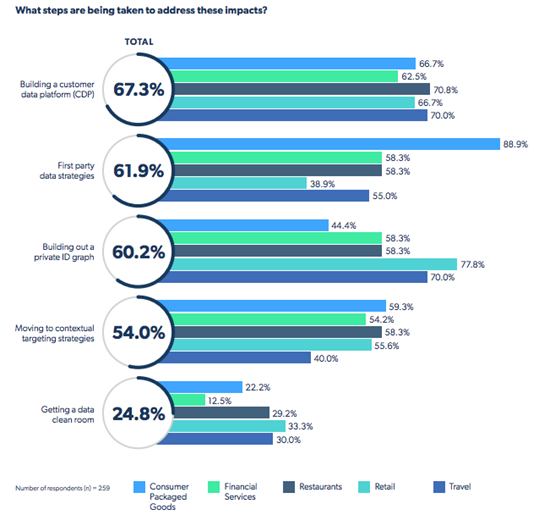Email for the Win
Time to rise up!
Let’s look at email marketing with the backdrop of a cookie-less world with the demise of third-party cookies.
This past week I was on a Zoom call with a fellow marketer asking for some marketing strategy advice.
No sooner did the words email marketing leave my mouth than I heard a gasp from my colleague. Email? Really, he inquired with a surprised look on his face. By the response, you’d think I was suggesting dial-up internet or an AOL CD.
Everything old is new again. We’ve heard it all before. The long list of marketing tactics that are now declared dead every time some new shiny object appears.
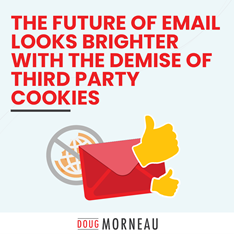 THE FUTURE OF EMAIL LOOKS BRIGHTER WITH THE DEMISE OF THIRD-PARTY COOKIES
THE FUTURE OF EMAIL LOOKS BRIGHTER WITH THE DEMISE OF THIRD-PARTY COOKIES
For those who understand the value of first-party data done well, email marketing as a proven tactic shouldn’t come as a surprise.
However, today we view email marketing through yet another new lens.
OLD NEWS - Social media accounts are blocked, content distribution limited (unless you pay), accounts canceled, and the loss of that data (connection to your customers).
NEW REALITY - The Death of Party Cookies. The loss of access to this data is predicted to reduce digital advertising return on ad spend by increasing the cost of ads all the while reducing the ability to target buyers with intent.
It’s a nice story, right?
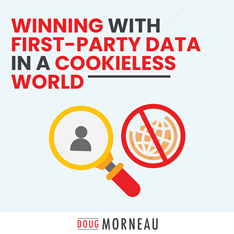
The changes are forcing nearly all marketers (98%) to take active steps to prepare. Most of them (69%) are trying to take these steps with agency partners and vendors. Their top three actions: building a customer data platform (CDP), strategizing around first-party data, and building out a private ID graph.
WHAT IS FIRST-PARTY DATA?
First-party data is the information that companies can collect from their own sources. In other words, all information about customers from both online and offline sources, such as the company's website, app, CRM, social media, email lists, SMS subscribers, or surveys are all first-party data.
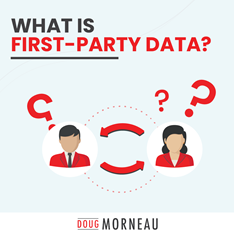 The first-party data can include information as follows:
The first-party data can include information as follows:
- demographics
- visited websites & interactions
- purchase history
- interests
- time spent on the website
- email subscribers
- SMS subscribers
- social media
- first-party cookies
522 brand marketers in the US, the UK, France, and Germany conducted by Sizmek, 85% of US respondents and 75% of respondents in Western Europe said that increasing their use of first-party data is a high priority.
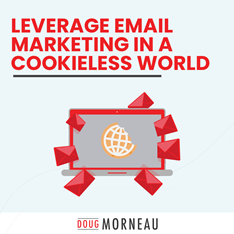 First and third-party cookies are both to track user behavior. They have similar purposes but are collected and used in different ways.
First and third-party cookies are both to track user behavior. They have similar purposes but are collected and used in different ways.
First-Party Cookies
First-party cookies are directly stored by the website (or domain) you visit. These cookies allow website owners to collect analytics data, remember language settings, and perform other useful functions that provide a good user experience.
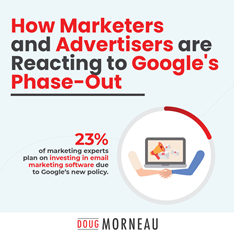
An example of a first-party cookie is when a user signs into a website, like Pier1. The web browser will send a request in a process that provides the highest level of trust that the user is directly interacting with Pier1. The web browser saves this data file to the user’s computer, under the “Pier1.com” domain. If first-party cookies were blocked, a user would have to sign in every time they visited, and they wouldn’t be able to purchase multiple items while shopping online because the cart would reset after every item that was added.
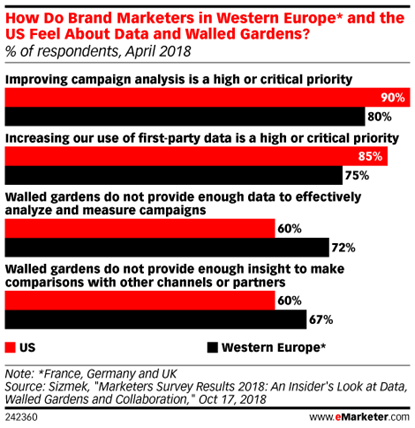
WINNING WITH FIRST-PARTY DATA IN A COOKIELESS WORLD
With Third-party cookies, sunsetting, fist-party cookies, and data are more vital and critical to success than ever before. While this change to the established status quo may feel unsettling, it is important to remember that not all cookies are going away. First-party cookies are very much still operational, and for now, at least, they’re going nowhere. As a business, you can and should still leverage these to your fullest advantage.
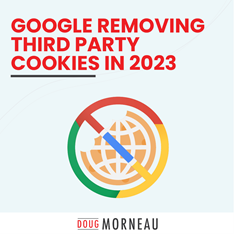
Google isn’t changing any policies for how publishers collect or use data gathered directly from users. So, a publisher that uses Google’s ad tech will still be able to sell ads that are targeted based on that publisher’s own first-party data.
Of course, first-party cookies still have their limitations. While we have access and insight into our audience’s behavior within our own properties, we’re flying blind regarding their actions across other domains. When we’re accustomed to this wider method of “joined-up thinking” to create omnichannel campaign strategies, it’s clear we’ll have a bit of recalibration to do.
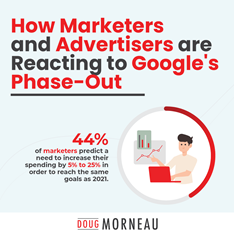 Remarketing will survive...
Remarketing will survive...
Thankfully, one of display advertising's most effectie strategies is here to stay because it relies on first-party cookies, and not third-party cookies. First-party cookies are different because they are often used to improve user experience through saved logins and user preferences, while also providign website owners with basic data about the user.
Remarketing works by collecting an anonymous list of users who visit your site and serving ads to those users programmatically elsewhere on the web. Since the advertiser is serving ads to those users programmatically elsewhere on the web. Since the advertiser is using data they ahve collected first-hand, the phase-out of third-party cookies will not affect this tactic. This will also include remarketing on social platforms, for example, serving ads on Facebook & Instagram to users who have visited your site.
What cookie types are there?
 There are three types of cookies:
There are three types of cookies:
First-party cookies are stored under the same domain you are currently visiting. So, if you are on example.com, all cookies stored under this domain are considered first-party cookies. Those cookies are usually used to identify a user between pages, remember selected preferences, or store your shopping cart. You can hardly find a website nowadays that does not use first-party cookies.
Third-party cookies, as explained before, are cookies that are stored under a different domain than you are currently visiting. They are mostly used to track users between websites and display more relevant ads between websites. Another good example is a support chat functionality provided by a 3rd party service.
Second-party cookies are a questionable topic. Some people might say they don't exist at all. In general, second-party data is some first-party data shared between partners. In this sense, second-party cookies are just part of that data related to cookies.
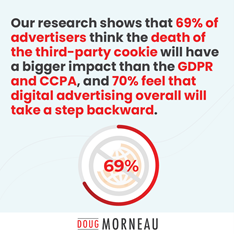
LEVERAGE EMAIL MARKETING IN A COOKIELESS WORLD
Email marketing will be more important than ever.
Email marketing is decades-old, sure, but don’t forget that it is an effective cookie-less marketing channel to drive sales and nurture relationships, but also for understanding customers.
Email marketing allows you to collect customer data through opt-ins. Once you have a foundation of subscriber data, it can be segmented based on location, company size, positions, and so forth.
I believe email will become the go-to first-party data targeting solution as third-party cookies are being phased out. Your business can market to customers when they’ve left a website. You can collect different information to personalize messages and experiences.
 Email lists can be used inside advertising platforms like Google Ads to improve quality scores. Subscribers can be retargeted and brought back to convert. Everything that third-party cookies provided can be achieved with proper email marketing
Email lists can be used inside advertising platforms like Google Ads to improve quality scores. Subscribers can be retargeted and brought back to convert. Everything that third-party cookies provided can be achieved with proper email marketing
Is now the time to ask for additional email marketing resources?
Team, Budget, New Tech to support the vision for growth?
With your CMO and CFO looking to maximize ROAS - return on advertising spend in 2022 this major shift in the digital advertising world opens the door to take leadership and present a solution for the future.
If your advertising strategies rely on third-party data, start considering alternatives now. As you continue to follow the news related to the phase-out, you should also vet any software or solutions that can help you better transition away from this type of cookie.
SOURCES
blog.hubspot.com/marketing/third-party-cookie-phase-out
epsilon.com/us/insights/trends/third-party-cookies
forbes.com/sites/forbesagencycouncil/2021/12/20/first-party-data-collection-is-more-crucial-than-ever
gartner.com/en/marketing/insights/articles/marketers-are-under-a-digital-ad-siege-and-must-now-convince-customers-to-share-data
chiefmarketer.com/in-a-cookie-less-world-will-email-become-the-new-ad-id/

 How to resolve AdBlock issue?
How to resolve AdBlock issue? 
